
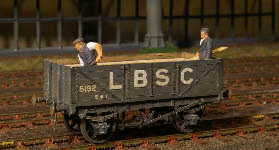


Last updated March 2021
The Brighton used a variety of different types of brake vans from the Stroudley period through to Robert Billinton’s time as CME and later when Panter was appointed as Superintendent for rolling stock.
One particular feature of the Brighton was the requirement that all goods trains had to have two brakes, one at each end, as specified in the rule book. I discovered , when I started to look at an operating timetable for Plumpton Green just how useful this is. Unfitted goods wagons must not be left on the mainline, unless a brake van is attached, so with a brake at both ends, the train can be split, part left on the mainline, and the other part shunted. With only a single brake at one end, shunting in one direction (from either up or down) would not be possible without shunting the whole train off the mainline first.
The early Stroudley vans were small and rather under weight at only 7 tons (later increased to 8, 9 or 10 tons). They were originally fitted with lantern lookouts, but these were later removed, probably sometime before 1910. These vehicles had side doors opening directly into the guard’s department and could therefore be used for small parcels, and so were termed ‘road vans’. As goods trains became heavier these vans were considered too small for general use and some inevitably ended up as departmental vehicles, used for example on engineer’s trains.
A Southern Railway experiment to pair two of these vans together (with a single guard between them) was not a great success and was soon abandoned. The last of these vans survived until 1938 as an Engineer’s Dept vehicle, painted in red oxide. I have painted my ballast brakes (and ballast wagons) in red oxide, but there seems to be some doubt about whether this is in fact correct for the LBSC period.
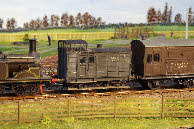
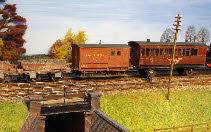 The two vans shown here are both etched brass Roxey Chatham kits, one shown (left) with the lantern lookout intact, and the other (right) without, and used as a ballast brake. The dumb buffered ballast wagons are all scratchbuilt from plasticard.
The two vans shown here are both etched brass Roxey Chatham kits, one shown (left) with the lantern lookout intact, and the other (right) without, and used as a ballast brake. The dumb buffered ballast wagons are all scratchbuilt from plasticard.
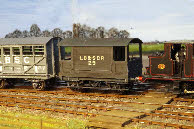
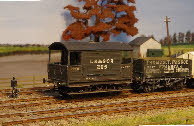 Robert Billinton, as successor to Stroudley in 1889, produced a new design in 1899 with tare weights between 9 and 12 tons, with verandas at both ends. The vehicle on the left is an etched brass Chivers kit, and that on the right is a plastic scratchbuilt model.
Robert Billinton, as successor to Stroudley in 1889, produced a new design in 1899 with tare weights between 9 and 12 tons, with verandas at both ends. The vehicle on the left is an etched brass Chivers kit, and that on the right is a plastic scratchbuilt model.
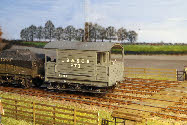 A much heavier (20 ton) six-
A much heavier (20 ton) six-wheel version of the same van (with almost identical dimensions) was developed in 1902, as shown in the photo, left, another Chivers kit. Chivers Finelines now appear to be owned by Parkside Dundas, but these etched brass kits do not seem to be available.
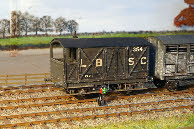 Albert Panter was appointed as Carriage and Wagon Works Manager in 1898, under Robert Billinton and was promoted to C&W Superintendent in 1911, with autonomous powers. He subsequently produced three new designs: a 15 ton, outside frame, single veranda ‘road-
Albert Panter was appointed as Carriage and Wagon Works Manager in 1898, under Robert Billinton and was promoted to C&W Superintendent in 1911, with autonomous powers. He subsequently produced three new designs: a 15 ton, outside frame, single veranda ‘road-van’ type shown here (scratchbuilt, and a bit modern for Plumpton Green in 1910!); a 20 ton, 6 wheel, vehicle of similar design; and finally a 20 ton double veranda brake, looking like a stretch version of the R Billinton brakes. These last two, being built in 1916 and 1922 are definitely too modern for Plumpton.
The Brighton used a variety of different types of brake vans from the Stroudley period through to Robert Billinton’s time as CME and later when Panter was appointed as Superintendent for rolling stock.
One particular feature of the Brighton was the requirement that all goods trains had to have two brakes, one at each end, as specified in the rule book. I discovered , when I started to look at an operating timetable for Plumpton Green just how useful this is. Unfitted goods wagons must not be left on the mainline, unless a brake van is attached, so with a brake at both ends, the train can be split, part left on the mainline, and the other part shunted. With only a single brake at one end, shunting in one direction (from either up or down) would not be possible without shunting the whole train off the mainline first.
The early Stroudley vans were small and rather under weight at only 7 tons (later increased to 8, 9 or 10 tons). They were originally fitted with lantern lookouts, but these were later removed, probably sometime before 1910. These vehicles had side doors opening directly into the guard’s department and could therefore be used for small parcels, and so were termed ‘road vans’. As goods trains became heavier these vans were considered too small for general use and some inevitably ended up as departmental vehicles, used for example on engineer’s trains.
A Southern Railway experiment to pair two of these vans together (with a single guard between them) was not a great success and was soon abandoned. The last of these vans survived until 1938 as an Engineer’s Dept vehicle, painted in red oxide. I have painted my ballast brakes (and ballast wagons) in red oxide, but there seems to be some doubt about whether this is in fact correct for the LBSC period.

 The two vans shown here are both etched brass Roxey Chatham kits, one shown (left) with the lantern lookout intact, and the other (right) without, and used as a ballast brake. The dumb buffered ballast wagons are all scratchbuilt from plasticard.
The two vans shown here are both etched brass Roxey Chatham kits, one shown (left) with the lantern lookout intact, and the other (right) without, and used as a ballast brake. The dumb buffered ballast wagons are all scratchbuilt from plasticard.
 Robert Billinton, as successor to Stroudley in 1889, produced a new design in 1899 with tare weights between 9 and 12 tons, with verandas at both ends. The vehicle on the left is an etched brass Chivers kit, and that on the right is a plastic scratchbuilt model.
Robert Billinton, as successor to Stroudley in 1889, produced a new design in 1899 with tare weights between 9 and 12 tons, with verandas at both ends. The vehicle on the left is an etched brass Chivers kit, and that on the right is a plastic scratchbuilt model. A much heavier (20 ton) six-
A much heavier (20 ton) six- Albert Panter was appointed as Carriage and Wagon Works Manager in 1898, under Robert Billinton and was promoted to C&W Superintendent in 1911, with autonomous powers. He subsequently produced three new designs: a 15 ton, outside frame, single veranda ‘road-
Albert Panter was appointed as Carriage and Wagon Works Manager in 1898, under Robert Billinton and was promoted to C&W Superintendent in 1911, with autonomous powers. He subsequently produced three new designs: a 15 ton, outside frame, single veranda ‘road-